















Ford Fiesta |
|---|
|
| Topic Navigation |
|---|
|
Wikipedia: Ford Fiesta
Subtopics Dunlop Ford Fiesta Championship Page Sections History Photographs Article Index Documents |
History
The following section is an excerpt from Wikipedia's Ford Fiesta page on 21 December 2017, text available via the Creative Commons Attribution-ShareAlike 3.0 Unported License.
The Ford Fiesta is a supermini marketed by Ford since 1976 over seven generations and manufactured globally, including in Europe, Brazil, Argentina, Mexico, China, India, Thailand, and South Africa.
In 2010, the sixth generation Fiesta (Mark VI) was introduced worldwide, making it the first Fiesta model to be sold in North America since the Fiesta Mark I was discontinued at the end of 1980.
Ford has sold over 16 million Fiestas since 1976, making it one of the best selling Ford marques behind the Escort and the F-Series.
The Fiesta was originally developed under the project name "Bobcat" (not to be confused with the subsequent rebadged Mercury variant of the Ford Pinto) and approved for development by Henry Ford II in September 1972, just after the launch of two comparable cars – the Fiat 127 and Renault 5. More than a decade earlier, Ford had decided against producing a new small car to rival BMC's Mini as the production cost was deemed too high, but the 1973 oil crisis saw a rise in the already growing demand for smaller cars.
The Fiesta was an all new car in the supermini segment, and was the smallest car yet made by Ford. Development targets indicated a production cost US$100 less than the current Escort. The car was to have a wheelbase longer than that of the Fiat 127, but with overall length shorter than that of Ford's Escort. The final proposal was developed by Tom Tjaarda at Ghia. The project was approved for production in late 1973, with Ford's engineering centres in Cologne and Dunton (Essex) collaborating.
Ford estimated that 500,000 Fiestas a year would be produced, and built an all-new factory near Valencia, Spain; a trans-axle factory near Bordeaux, France; factory extensions for the assembly plants in Dagenham, UK. Final assembly also took place in Valencia.
The name Fiesta (meaning "party" in Spanish) belonged to General Motors, used as a trim level on Oldsmobile estate models, when the car was designed and was freely given for Ford to use on their new B-class car. After years of speculation by the motoring press about Ford's new car, it was subject to a succession of carefully crafted press leaks from the end of 1975. A Fiesta was on display at the Le Mans 24 Hour Race in June 1976, and the car went on sale in France and Germany in September 1976; to the frustration of UK dealerships, right hand drive versions only began to appear in January 1977. Its initial competitors in Europe, apart from the Fiat 127 and Renault 5, included the Volkswagen Polo and Vauxhall Chevette. Chrysler UK were also about to launch the Sunbeam by this stage, and British Leyland was working on a new supermini which was launched as the Austin Metro in 1980.
First generation (1976–1983)
The Fiesta was initially available in Europe with the Valencia 957 cc (58.4 cu in) I4 (high compression and low compression options), and 1,117 cc (68.2 cu in) engines and in Base, Popular, L, GL (1978 onward), Ghia and S trim, as well as a van. The US Mark I Fiesta was built in Cologne, West Germany, but to slightly different specifications; US models were Base, Decor, Sport, and Ghia, the Ghia having the highest level of trim. These trim levels changed very little in the Fiesta's three-year run in the US, from 1978 to 1980. All US models featured the more powerful 1,596 cc (97.4 cu in) engine, (which was the older "Crossflow" version of the Kent, rather than the Valencia) fitted with a catalytic converter and air pump to satisfy strict Californian emission regulations), energy-absorbing bumpers, side-marker lamps, round sealed-beam headlamps, improved crash dynamics and fuel system integrity as well as optional air conditioning (a/c was not available in Europe). In the US market, the Ford Escort replaced both the Fiesta and the compact Pinto in 1981, competing with the Chevrolet Chevette and Chevrolet Cavalier.
Second generation (1983–1989)
The Fiesta Mark II appeared in August 1983 with a revised front end and interior, and a bootlid mirroring the swage lines from the sides of the car. The 1.3 L OHV engine was dropped, being replaced in 1984 by a CVH powerplant of similar capacity, itself superseded by the lean burn 1.4 L two years later. The 957 and 1117 cc Kent/Valencia engines continued with only slight alterations and for the first time a Fiesta diesel was produced with a 1,600 cc engine adapted from the Escort.
The new CTX continuously variable transmission, also fitted in the Fiat Uno, eventually appeared early in 1987 on 1.1 L models only.
The Mk2 Fiesta core range (excluding special editions) was made up of the following model variants; Popular, Popular Plus, L, Ghia, 1.4S('86 onwards) and finally the XR2.
Third generation (1989–1997)
The third generation Fiesta Mark III, codenamed BE-13 was unveiled at the end of 1988 and officially went on sale in February 1989. The car was based on a new platform ditching the old car's rear beam axle for a semi-independent torsion beam arrangement and looked radically different, addressing the principal weakness of the previous generation – the lack of a 5-door derivative, something that was by then available in its major rivals such as the Fiat Uno, Peugeot 205 and 106 and Opel Corsa/Vauxhall Nova. The other main change was to the running gear – the improved HCS (High Compression Swirl) version of the Kent/Valencia powerplant. The CVH units from the second generation were carried over largely unmodified. The diesel engine was enlarged to a 1.8L capacity.
As for sports models, the XR2i was launched in August 1989 with an eight-valve CVH (standing for "compound valve-angle hemispherical combustion chamber") engine with 104 PS (76 kW). This was the first Fiesta to have a fuel-injected engine. This was then replaced by a Zetec 16 valve version in 1992, which also saw the RS Turbo being supplanted by the RS1800 as the CVH engine was being phased out. The RS1800 shared its 1.8 litre Zetec fuel-injected engine with the 130 PS (96 kW; 130 bhp) version of the then current Ford Escort XR3i and had a top speed of 125 mph (201 km/h). The XR2i name was also dropped in early 1994, and the insurance-friendly "Si" badge appeared in its place on a slightly less sporty-looking model with either the 1.4 L PTE (a development of the CVH) or the 1.6 L Zetec engine.
From 1995 the vehicle was built and sold at the same time as the new Mark IV. To distinguish the car, trim levels were revised, and it was marketed as the "Fiesta Classic". This version continued until production finally ceased in 1997.
Fourth generation (1995–2002) (UK Mk4/5)
The Fiesta Mark IV (internal code name was BE91) was launched in 1995 and became Britain's best-selling car from 1996 to 1998.
The model featured a range of new Zetec-SE engines, available in 1.25 L and 1.4 L forms, the 1.8 litre diesel engine was slightly modified for the Mark IV, now marketed as the "Endura DE". Lower specification models remained available with what would be the final edition of the Kent 1.3 L OHV engine, now known as Endura-E. As well as the major changes to the chassis, the Mark IV also benefited from a new interior and exterior styling, including a soft painted instrument panel for the first year of production, albeit maintaining similar dimensions to the Mark III, along with the platform and the basic body structure, most noticeably the side door openings. The RS1800 and RS Turbo models were not carried over to the updated Fiesta range.
The Mark IV Fiesta shared a production line and design with the Mazda 121, which sold in much lower volumes than Fiesta did.
In Brazil a 1.0 litre (Endura Engine) version was available in Popular trim level. Also a 1.3 litre (Endura) and a 1.4 litre 16V (Zetec-SE) was available in CLX trim level; it was sold in Argentina and Chile. The UK trim level line up had relatively few changes over the years: (1995, Encore, LX, Si, Ghia; 1996, Ghia X added as range-topper; 1998, Si replaced by Zetec, petrol LX models briefly renamed Zetec LX, Ghia X models axed; 1999, Finesse added between Encore and Zetec).
In 1997, the Mark IV was introduced in South Africa, the first time the Fiesta had been sold in that market. Only one engine was available, the 1.3 litre Endura E. It subsequently won the South African Car of the Year award. The 1.3 litre engine was replaced with the 1.4 litre PTE (CVH) engine in 1999.
The Mark IV was not sold in North America.
Sixth generation (2008-2017) (UK Mk7)
The sixth generation, or Ford Fiesta Mark VI, was shown in concept form as the Ford Verve at the Frankfurt Motor Show in September 2007 and marketed in principal European markets, Australia and the United States. This model is based on Ford's new global B-car platform. The sixth generation is known as Mark VII in the United Kingdom. Production started at Ford's Cologne plant in Germany in August 2008. A second plant in Valencia, Spain started production in early 2009. Productions in China, Thailand and Mexico started from late 2008 to 2010. In Brazil the production of the hatch version started in the end of 2012, in São Bernardo do Campo in São Paulo. Soon, the saloon version will be produced in the same place.
A saloon version was launched in November 2008 at the Guangzhou Auto Show. It started sales the following year in China and from 2010 it became available across Asia and North America. It is not marketed in Europe,but marketed in Russia from 2015.
Seventh generation (2017–present) (UK Mk8)
On November 29, 2016, the seventh generation Fiesta (Mark VII, or Mark VIII in UK) was announced in Germany, being bigger, roomier, safer, more efficient and more upmarket. The Fiesta range will expand to include new additions: a compact crossover, called the Fiesta Active, and the luxury Fiesta Vignale.
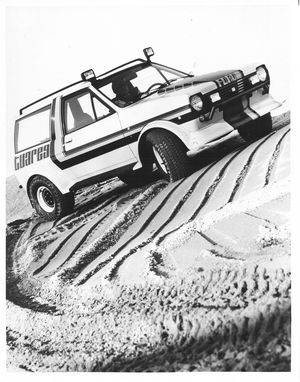 |
1978 Tuareg Ford Public Relations Photo DESERT FIESTA -- The Fiesta Tuareg -- a functional one-of-a-kind all-terrain vehicle -- is equipped for rugged off-road recreational use. Based on Ford Division's popular Fiesta, the Tuareg was a joint design project between Ford's Ghia Operation in Turin, Italy, and the Ford Design Center in Dearborn, Mich. The concept car is built on a 90-inch wheelbase and powered by a 1.1-liter engine with a four-speed manual transmission. The Fiesta Tuareg will be a featured attraction at Ford Division auto show displays this year. View photo of 1978 Ford Fiesta Tuareg - 3.3MB |
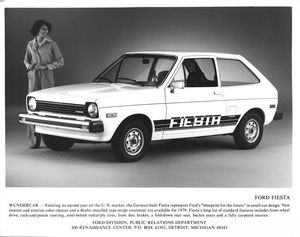 |
1979 Ford Public Relations Photo WUNDERCAR - Entering its second year on the U.S. market, the German-built Fiesta represents Ford's "blueprint for the future" in small-car design. New interior and exterior color choices and a dealer-installed tape-stripe treatment are available for 1979. Fiesta's long list of standard features includes front-wheel drive, rack-and-pinion steering, steel-belted radial-ply tires, front disc brakes, a fold-down rear seat, bucket seats and a fully carpeted interior. View photo of 1979 Ford Fiesta - 2.9MB |
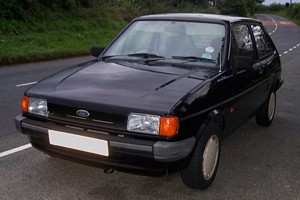 |
1987 MkII "Festival Edition" Photo by Norman Rogers Taken in North Nibley, Gloucestershire on August 11, 2004 View photo of 1987 Ford Fiesta MkII Festival Edition - 68KB |
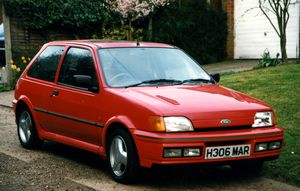 |
1991 RS Turbo in Radiant Red Photo by Brian Snelson This photo is licensed under the Creative Commons Attribution 2.0 Generic License. View photo of Ford Fiesta - 1.6MB |
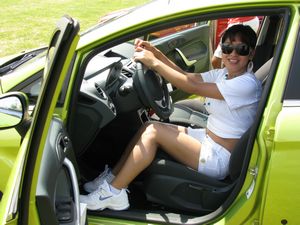 |
Photo ©2009 Bill Crittenden Massive Speed Cruise Jam 4 View photo of Ford Fiesta - 3,230KB |
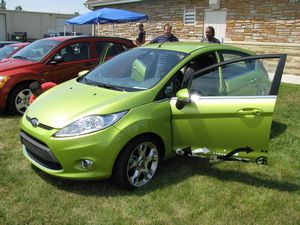 |
Photo ©2009 Bill Crittenden Massive Speed Cruise Jam 4 View photo of Ford Fiesta - 4,259KB |
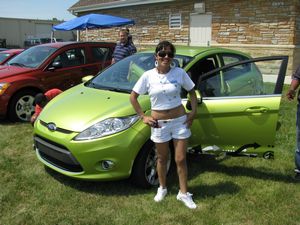 |
Photo ©2009 Bill Crittenden Massive Speed Cruise Jam 4 View photo of Ford Fiesta - 4,190KB |
| Date | Document Name & Details | Documents |
|---|---|---|
| 5 May 2011 | Safety Compliance Testing for FMVSS 201: Occupant Protection in Interior Impact, Upper Interior Head Impact Protection 2011 Ford Fiesta 4-Door Sedan S National Highway Traffic Safety Administration | PDF - 7.5MB - 169 pages |
| 23 June 2011 | Safety Compliance Testing for FMVSS 301R: Fuel System Integrity - Rear Impact 2011 Ford Fiesta National Highway Traffic Safety Administration | PDF - 7.7MB - 57 pages |
| 18 August 2011 | Safety Compliance Testing for FMVSS No. 110: Tire Selection and Rims 2011 Ford Fiesta Four-Door Passenger Car National Highway Traffic Safety Administration | PDF - 4.4MB - 38 pages |
| 30 November 2011 | Safety Compliance Testing for FMVSS 126: Electronic Stability Control Systems 2011 Ford Fiesta National Highway Traffic Safety Administration | PDF - 5.0MB - 63 pages |
